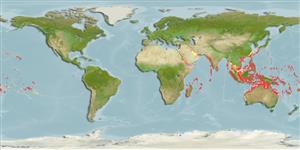Environment: milieu / climate zone / depth range / distribution range
Ecology
Marine; reef-associated; depth range 0 - 90 m (Ref. 128797), usually 10 - ? m (Ref. 1602). Tropical; 30°N - 32°S, 29°E - 130°W
Indo-Pacific: Red Sea and East Africa (south to Coffee Bay, South Africa, Ref. 5372) to the Hawaiian Islands and Samoa, north to southern Japan, south to New South Wales, Australia and New Caledonia. Eastern Pacific: Galapagos Islands (Ref. 5227).
Size / Weight / Age
Maturity: Lm ? range ? - ? cm
Max length : 15.0 cm TL male/unsexed; (Ref. 5372)
Dorsal
spines
(total): 13 - 14;
Dorsal
soft rays
(total): 20-23;
Anal
spines: 3;
Anal
soft rays: 17 - 20;
Vertebrae: 24. Body is yellowish brown with two broad white vertical bars running across the body one from near the origin of the dorsal spine and the other from the middle of the back. A black bar runs vertically across the eye. There are numerous dotted horizontal stripes on the sides. The margin of caudal fin is transparent (Ref. 4855). Snout length 2.5-3.2 in HL. Body depth 1.5-1.8 in SL (Ref. 90102).
Occur in deeper lagoons and channels, and seaward reefs (Ref. 1602). Benthopelagic (Ref. 58302). Depth 2-61 m, usually below 10 m (Ref. 90102). Occur singly or in pairs (Ref. 37816). Common, omnivorous individuals that feed mainly on soft coral polyps (mainly on Sarcophyton tracheliophorum and Litophyton viridis), algae and zooplankton. Oviparous (Ref. 205). Form pairs during breeding (Ref. 205).
Life cycle and mating behavior
Maturity | Reproduction | Spawning | Eggs | Fecundity | Larvae
Distinct pairing (Ref. 205). Monogamous mating is observed as both obligate and social (Ref. 52884).
Myers, R.F., 1991. Micronesian reef fishes. Second Ed. Coral Graphics, Barrigada, Guam. 298 p. (Ref. 1602)
IUCN Red List Status (Ref. 130435)
Threat to humans
Harmless
Human uses
Fisheries: subsistence fisheries; aquarium: commercial
More information
ReferencesAquacultureAquaculture profileStrainsGeneticsElectrophoresesHeritabilityDiseasesProcessingNutrientsMass conversion
Tools
Special reports
Download XML
Internet sources
Estimates based on models
Preferred temperature (Ref.
123201): 24.7 - 29, mean 27.8 °C (based on 832 cells).
Phylogenetic diversity index (Ref.
82804): PD
50 = 0.5000 [Uniqueness, from 0.5 = low to 2.0 = high].
Bayesian length-weight: a=0.03090 (0.01881 - 0.05077), b=3.04 (2.90 - 3.18), in cm total length, based on LWR estimates for this species & Genus-body shape (Ref.
93245).
Trophic level (Ref.
69278): 2.9 ±0.2 se; based on diet studies.
Resilience (Ref.
120179): High, minimum population doubling time less than 15 months (Preliminary K or Fecundity.).
Fishing Vulnerability (Ref.
59153): Low vulnerability (10 of 100).
Nutrients (Ref.
124155): Calcium = 113 [58, 170] mg/100g; Iron = 0.887 [0.532, 1.450] mg/100g; Protein = 18.4 [17.3, 19.6] %; Omega3 = 0.122 [0.073, 0.199] g/100g; Selenium = 38.6 [21.2, 72.4] μg/100g; VitaminA = 45.2 [12.4, 160.4] μg/100g; Zinc = 1.6 [1.1, 2.3] mg/100g (wet weight);
